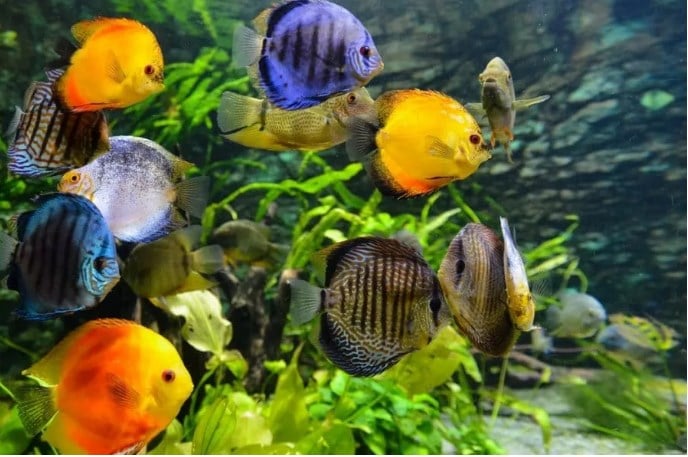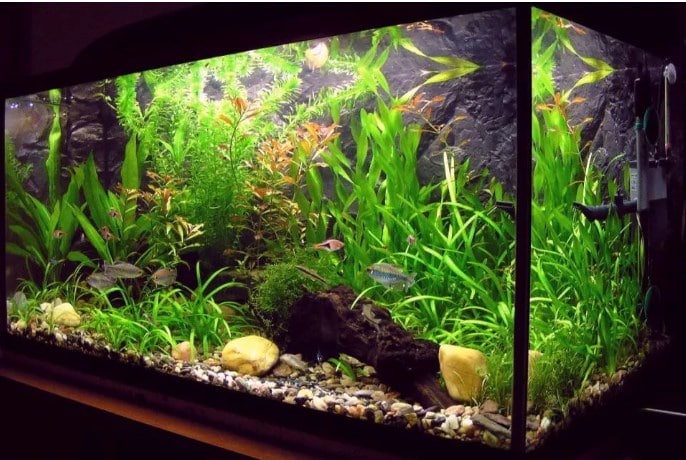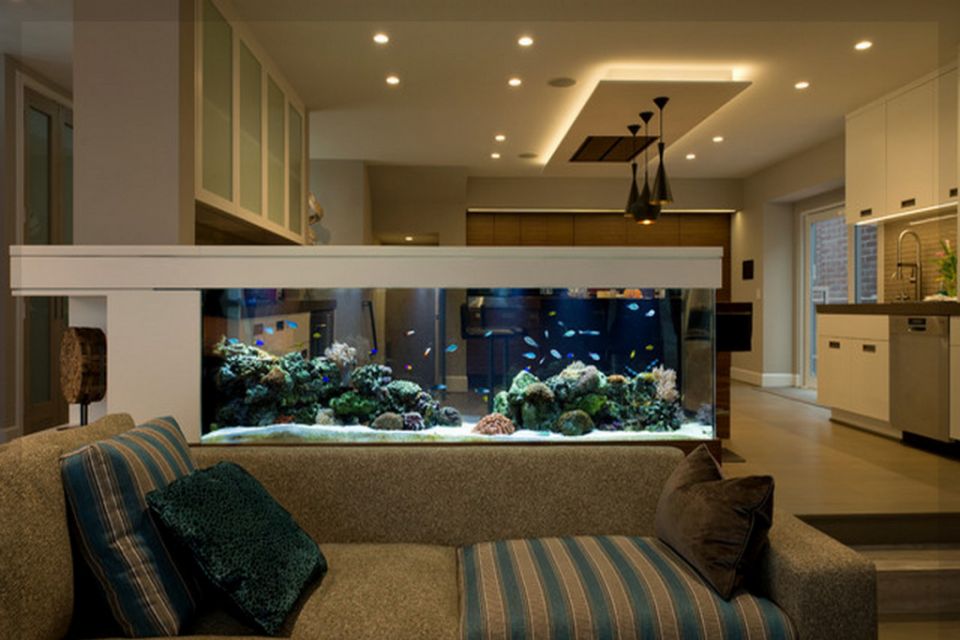The stocking density in the aquarium: How many fish per litre fit into your tank?
You have already learned how to set up an aquarium from our large, detailed guide. Once the tank has been retracted, most aquarists ask themselves about the fish. Due to the huge selection of fish that are available in pet shops, it is not surprising that you often see the following questions in Internet aquarium forums: “how many fish fit into my aquarium?”, “how many fish per liter?” or “stocking strength/stocking density in the aquarium? How many fish you can actually keep in your 54-60 litres / 112-120 litres / 180-240 litres and 350-450 litres aquarium, which factors influence the amount of fish in your aquarium and whether there is actually a rule of thumb for the stocking density (i.e. fish per litre/centimetre), you can find out in the following guide! Table of Contents
Overview: these factors determine how many fish can be kept in an aquarium!
In short, it is not possible to determine how many fish can be kept in an aquarium, because the number of too many individual factors is determined. In the following article we explain in detail why the stocking density depends on a certain factor. If you do not feel like reading everything, you will find a small overview of the various factors that determine the stocking density / stocking thickness and the quantity of fish per litre of water or centimetre of edge length below:
- size and shape of the aquarium: height / width / depth / volume
- Structure and decoration of the pool
- The technique of the aquarium
- The (social) behaviour of ornamental fish
- The age of the fish / the maximum size
- And many more individual factors

The rule of thumb for stocking density: How many fish per liter/centimeter?
A rule of thumb is widely used in aquaristics, because it is spoken of again and again in forums and actually also in the retail trade, as well as partly also in aquaristic books. This rule of thumb measures the number of fish that can be kept in an aquarium per litre of water or per centimetre of edge length. Sometimes this rule of thumb is also known in a slightly different way: it measures the number of litres of water or centimetres of edge length a fish needs to live in an aquarium. These guidelines are often published:
- 1 cm fish per 1 litre water or
- 1cm fish per 30 cm² area in the aquarium
Why a rule of thumb for the stocking density in the aquarium is not always meaningful
The rule of thumb for stocking density in the aquarium is measured as the amount of fish that can be used per centimetre of edge length or per litre of water. If you would occupy an aquarium according to the above mentioned guideline value, i.e. use one centimetre of fish per litre of water or one centimetre of fish per 30cm² of surface area, some difficulties would quickly arise. So one could go according to this formula in a 60 liters aquarium with an edge length of 60 centimeters in both variations of the rule of thumb 60 centimeters fish insert. For example, 20 fish that grow to 3 centimeters or 10 fish that grow to 6 centimeters or a fish that grows to 60 centimeters. If one also considers that decorations such as roots or stones and plants are accommodated in the aquarium, but this limitation of the absolute area is not even taken into account by the rule of thumb, then one notices that this formula quickly reaches its limits and can under no circumstances be applied for the establishment of a species-appropriate aquarium. The number of fish that can be kept in the aquarium depends on far too many factors and also to a large extent on the size of your tank.
When does a guideline value for stocking strength/density make sense?
To make the stocking density or stocking strength in the aquarium dependent on a rule of thumb is therefore anything but recommendable, nevertheless a guideline value can be useful for the determination of the quantity of fish in selected cases. Let’s imagine, we set up a medium sized 180 litre aquarium and ask ourselves the question how many schooling fish we can put into it. If one proceeds here after the guideline value that per centimeter of edge length one centimeter of fish can be used, i.e. with 100 centimeters of basin length 100 centimeters of fish then we come to the result that with an average fish length of 4 centimeters of swarm fish of for example 4 centimeters we can maintain 25 specimens (100 cm of edge length / 4 cm of fish length / fish = 25 fish) – a healthy and quite realistic value according to which one can definitely follow. Note that we have slightly modified the formula here: instead of assuming that only 100 centimeters of fish can be used in the entire aquarium, let’s say that 100 centimeters of fish alone can be used in the middle basin region. Before applying a rule of thumb for the stocking density in the aquarium, you should always find out which fish you can actually care for in the aquarium (size/type). You can find many different aquarium stocking suggestions here.
What does the number of fish in the aquarium depend on?

The amount of fish you can use in your 60 litre / 120 litre / 180-240 litre or 350-450 litre aquarium actually depends on many different factors. But let’s go through them little by little and explain them in more detail …
-
The size and shape of the aquarium
The first factor that determines the amount of fish in your aquarium is of course the size of the tank. Logically, only small species fit into a small aquarium – if one were to use the rule of thumb, 3 fish of 20 centimetres length could be used in a small 60 litre aquarium. You should therefore inform yourself in advance about the maximum size of the species you can use in your aquarium. Furthermore, the shape of your aquarium determines the stocking density or the stocking strength in the aquarium. For example, in a standard 180 litre basin with a height of “only” 40 centimetres, no scalars should be used, whereas in a 180 litre basin with a special height of 50 centimetres, the use of scalars would be possible.
-
The structure/ decoration of the aquarium:
How many fish fit into your aquarium depends on the structure of your aquarium. For example, in an aquarium that is equipped with a lot of decoration such as roots and stones, fewer fish per litre of water or per centimetre of edge length fit naturally. Also a dense planting in the aquarium impairs the quantity of fish. If you have a really densely planted aquarium or just a lot of decoration, then you should use less fish, especially in the bottom area.
-
The technique of the aquarium

Also the technique of your aquarium limits the amount of fish you can use in your aquarium. Let’s assume, for example, that your complete aquarium set only has a rather weak internal filter that circulates just enough water per hour to be sufficient for a 60 litre tank or not at all. In this case, you may want to reduce the stocking density in the aquarium a little to avoid looking at a green aquarium 3-4 days after the water change. If, for example, your pool has a large external filter that would also be suitable for larger pools, you can increase the stocking strength, i.e. the quantity of fish, a little – if the other factors allow it.

Of course, the amount of fish you can keep in your aquarium also depends on the behaviour of the fish. For example, in an aquarium you should not only use animals that are mainly in the middle of the tank. Instead, a balanced combination of aquarium inhabitants who are close to the ground and more inclined to swim and who are in the middle/top should be used. A big limiter for the stocking density in the aquarium is also the social behaviour of the animals. For example, the use of perch, such as the butterfly cichlid, which usually spawn near the bottom, limits the number of other ground-level fish. Otherwise the perch would be disturbed and the brood care would stop, in addition they could attack and hurt other fish, that push into your precinct. It must also be clear whether the desired fish must be kept in a group or whether they can be used in pairs or alone in the aquarium: for example, there are catfish for the 54/60 litre aquarium, which could be kept in a small aquarium purely by size, but only as a group of 5-6 animals, which strongly limits the remaining stock.
-
The age of the fish and the maximum size
Most of the fish purchased in pet shops are young animals. Based on their size at the time of purchase, you can probably use more fish in your aquarium. It is therefore necessary that you inform yourself so that you are aware of the maximum body length of the animals. This is a factor which limits the stocking density / stocking thickness once again and should therefore be taken into account.
-
What we have not addressed
Please note that in the above points we have actually only addressed the factors that affect the amount of fish per litre of water or centimetre of edge length. Of course, you should also make the stocking of your aquarium dependent on the needs of the aquarium fish, on their preferred water quality, and on the origin of the animals in species tanks.
The stocking density: How many fish can you keep in an aquarium?
In order to finally give an answer to the question how many fish fit into an aquarium, we have prepared the following overview, which depends on the above mentioned factors. But of course also by the needs of your desired aquarium inhabitants. The overview briefly explained: The column Max. Body length of the animals describes the maximum size a fish may have that is kept in the aquarium – Attention: here no consideration is given to the height of the fish: a scalar, for example, is much higher than an ordinary tetra. The number of fish at the bottom and in the middle naturally depends on their size. You should also inform yourself in advance which animals you can keep in your aquarium and which you should keep.
| aquarium size | Fish bottom | Fish middle / top | Max. Body length of animals |
| 54 – 60 litres Aquarium | 8-12 animals depending on size | 8-12 animals depending on size | 4-6 cm |
| 112 – 120 litres Aquarium | 8-12 animals depending on size | 10-15 animals depending on size | 4-6 cm |
| 180 – 240 litres Aquarium | 12-20 animals depending on size | 15-25 animals depending on size | 8-10 cm |
| 350 – 450 litres Aquarium | 15-25 animals depending on size | 30-45 animals depending on size | 12-14 cm |

Conclusion: to define the stocking density/stocking strength in the aquarium on the basis of a guideline
In general, the amount of fish you can keep in your aquarium is difficult to determine using a rule of thumb. The quantity depends far too much on individual factors, such as the structure of the basin. However, a rule of thumb can be used for rough orientation – after all, it gives an approximate overview of the possible stocking density. You should therefore always inform yourself about the needs and requirements of the fish you want to use in the aquarium, as well as about the social behavior, because only the size of a fish does not necessarily determine whether it can be kept in a certain aquarium. Especially as a beginner you can be inspired by the above illustration: it gives you an idea about the maximum size a fish can have in a certain aquarium basin size, as well as the amount of fish you can keep in different basin regions.



